
There will be plenty to notice at any café that shares space with a barber’s shop. And so it was the case at Sharps Coffee Bar on Windmill Street. The café is at the front of the barber’s shop which is separated from the tables by a glass wall: people watching in a type of human goldfish bowl. The counter was on the left of the shop as we walked in and it was great to see that in addition to the usual espresso based drinks there was an aeropress coffee available (as well as batch brew). Given the chemistry of pre-brewed coffee, I tend to pass on batch brews though I am aware that there are many people who enjoy speciality coffee who will disagree with me. However, given that the barista on the day was “still perfecting” his aeropress recipe, I enjoyed instead a long black prepared with The Barn roasted beans.
The sign in the window suggested that “maintenance matters” which is something that I am sure that we can all agree on, whether it is on haircuts, coffee equipment or even equipment in a science lab. A stitch in time saves nine so they say. On the board listing the prices, it was good to see that Sharps coffee bar mentioned the use of almond milk. Although personally I generally drink black coffees, cross contamination can be an issue for allergy sufferers and so it is always helpful to be alert to the use of nut-based milks when they are used (you can read more here). Edibles were supplied by Kaffeine. Behind the bar there were a couple of trough-like sinks while the contrast in the wood and the tiling on either side of the bar provided another avenue of thought.

In the window, a row of cacti caught my attention. Cacti seem known for two things. One is that they are (generally) prickly and the other that they are extremely water efficient. But these two facts can also apparently be linked. Some cacti use their spikes or hairs to change the local atmosphere around them so that air is trapped in the hair or that air flow is reduced. Both of these measures would help to prevent water loss from the main body of the plant. It is an example of the structure of something affecting the environment around it. Similar effects can be seen on the hairs on a spiders legs which trap air allowing the spiders to survive if they are submerged as well as to waterproof the legs in more general times. Some plants similarly use hairs (and therefore the air trapped in them) to waterproof their leaves. The benefit of this for the plant is that waterproof leaves mean that drops of water roll off of them causing the leaves to be self-cleaning. This is an effect that people are trying to mimic in order to make self-cleaning surfaces for human use.

Structures can also be used to trap sound waves either deliberately with meta-materials or, almost accidentally such as the whispering galleries of cathedral domes. Moreover the hairs themselves can act as part of a sound detection system. Human ears for example have tiny hairs in the cochlea. As a sound comes in and these hairs vibrate, the movement of these hairs gets converted to a nerve impulse that we can eventually ‘hear’. Perhaps this could take us into a consideration of what hearing is, what sound is and, in a Berkeley-type way whether we actually experience anything outside of ourselves at all. However, more directly it takes us back to the barber’s shop and how evolution has resulted in a wide variety of structural adaptations that allow different life forms to live optimally in their environment.
And with that, it would probably be time to sit back and enjoy another coffee.
Sharps coffee bar is at 9 Windmill Street, W1T 2JF







